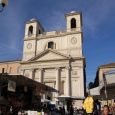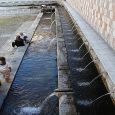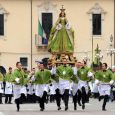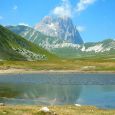LAquila
Advertisement
By Air
The Eagle has a tourist airport which has recently been adapted to receive civil traffic.Parks Airport located in the hamlet of Preturo about 6 km west of the city was in fact the main airport of the G8 and the Eagle after the earthquake that struck LAquila in April of 2009 has become the point of reference of Civil Protection who has established his national basis.The structure has a long asphalt runway 1410 meters wide 23 the altitude is 671 m / 2201 feet the orientation of the slopes is RWY 18-36. The airport carries out activities in accordance with the rules and schedules VFR.Inside there are also a restaurant a children's play area a flight school and a relaxation area.It is connected to the city and the highways by a freeway and is currently managed Aeroclub LAquila.
By Train
Considering the difficult position of the city rail transport are not developed with the main axes of national communication.The city is crossed by the railway line Terni - Sulmona, single track and not electrified.The train service is operated by the FCU between Terni and LAquila and Aquila in the stretch by Trenitalia - Sulmona.
By Bus
Public transport is managed by WADA, the company's Mobility Aquilana, with headquarters and terminus in the Terminal Collemaggio.The main lines are the 77 and 79 longitudinally through the city connecting the center with the west (Hospital, Airport and University Centre of torque) and the East (Pianola and Polo Universitario di Roio) through the densely populated residential neighborhoods Tower of Santa Barbara.Other routes are very busy metropolitan-The Eagle and The Eagle-Paganica Fonte Cerreto (base of the ski resort of Campo Imperatore) both of which are departing from Terminal Collemaggio which is also a parking lot in exchange.
By Road
The connection between the A24 and the roads is provided by Route 17 b (The Eagle East - Bazzano) dual carriageway in each direction from Route 17 and a (LAquila Ovest - Pianola) single-lane and well-known Mausonio name.The main roads through the city are Route 17 and the Abruzzo Appulo Sannitico: Antrim - Foggia.Important road that connects one side with the Rieti and LAquila, LAquila on the other, with tracing the ancient Adriatic coast Tratturo The Eagle-Foggia in its initial part.SS 80 of the Gran Sasso of Italy: LAquila - Giulianova. Ancient road from LAquila Teramo.SS 5 a Vestina Sarentina: LAquila - Celano.The ancient road that connects with Eagle Marsica via the 'Plateau of Castles.
Basilica of San Bernardino
is a Catholic church which is located at the Eagle.It was erected with the adjacent convent, between 1454 and 1472 in honor of St. Bernardino of Siena.The remains of the saint are kept inside the church in a special mausoleum.The earthquake of 6 April 2009 has severely damaged the apse and the bell tower.The history of the founding of the church are related to the figure of the saint who, despite being ill for some time, in 1444 he went to 'Eagle groped to pacify the warring factions.At his death, which occurred May 20 in the very capital of Abruzzo, citizenship asked and obtained from Pope Eugene IV permission to house the remains.The first phase of work, interrupted several times, began in 1454 and ended in 1472 with the construction of the dome which allowed the movement of the remains inside the basilica .
Exhibition Palace
is a building of historical Aquila now the Regional Council d Abruzzo.It is located in Via Iacobucci, adjacent to the Villa Comunale the place where once stood the seventeenth-century convent of St. Michael the Archangel.The monastery with the church that was contained within were restored in the late eight hundred -style neo-classical and, as part of a complex work of urban redevelopment of the entire area south of the city in 1888 the architect Charles Waldis realized This picturesque building with a facade to semicircular portico.It was called the Exhibition Palace in clear reference to eponymous palace of Rome built a few years earlier though for the shape of the facade is known primarily as a House.Hosted for a short time the main shows and exhibitions held in cities until after the war the original structure and the new religious monuments House new buildings were added which allowed the regional offices in localizzazzione.A short distance from the Exhibition Palace also stands Palazzo Centi that since 2003 is home to the President of the Abruzzo Region.
Fountain of 99 Spouts
also known as the Rivera is a historical monument of Aquila.Located in the Rivera one of the oldest of the old town near the river Aterno, the fountain is made up of ninety-three masks in stone spouts and six singles, most of them from the springs water.According to tradition the taps represent the ninety-nine castles in the thirteenth century participated in the founding of the Eagle.A plant trapezoidal high-impact perspective originally consisted of an elaborate system of symbols astrological repeated additions in 1582 by Alessandro Ciccarone.The fountain is on three sides and is placed low profile compared to the road on the open side ends with a staircase that looks at the medieval church of St. Vitus.The perimeter of the fountain which for a leaning to the side walls of the city , is characterized by the intertwining of blocks of stone white and pink comes from the nearby quarry Genzano di Sassa, also in front of the Basilica of Santa Maria di Collemaggio and in other monuments of the Eagle.It consists of five [tanks] located on different levels and slightly offset each other, the highest of which is fed water through special masks. This structure was specifically designed to allow the washing of clothes that came there every day until the first decades of the twentieth century.
Amiternum
was an ancient city Italic founded by the Sabines whose ruins stand today at a short distance from ' Aquila . Its name comes from the river, the Aterno fact, even if that crossed the city was originally located further north on the hill of Saint Victorinus and only later moved to the plain below where today is located a important archaeological site.Other important examples, including a Roman villa have been found recently in the surrounding area, near Coppito and Pizzoli.The city gave birth to one of the major Roman historians Sallust and has been the seat of the diocese together with the neighboring city of Forcona and Pitinum. Although it survived the fall of the Roman Empire Amiternum experienced a period of great decline and eventually disappear completely in the tenth century .
National Museum of Abruzzo
is the most important museum in the region on an artistic level is housed in 41 rooms of the Castle of LAquila in the courtyard and the first and second floor.On the ground floor, 2 rooms are relics archaeological, including many funerary stelae, but the most important is the Elephas meridionalis, the monumental remains of a mammoth, one of the largest in Italy (found in 1943 ).On the first floor, 10 rooms, there are works of sculpture and paintings from the late twelfth century.at the end of the fifteenth century. to be mentioned the works of unknown painters and sculptors, master of the Triptych Boffi, Silvestro dell Aquila, Saturnino Gatti and the delicate Madonna and Child.On the second floor works paintings, textiles, jewelry sacred by the early sixteenth century until 900.Works of great value, such as Nicholasof Guardiagrele, Francis Montereale, Bartolomeo di Giovanni, Pompey Cesura, Giovan Paolo Cardone, Bedeschini Julius, the Master of the Pit.Among the modern works those of Theophilus Patini and Francesco Paolo Michetti.
Spanish Fort
also known as Castle sixteenth century, is a fortress of Aquila.It was built over a huge military build-up of the project area occurred during the rule of Spanish in southern Italy in the first half of five hundred.Never used for war purposes, was used in six hundred as the residence of the governor Spanish and later as accommodation for soldiers French in eight hundred and Germans during the last World War.Restored in 1951 by the Superintendency of Monuments and Galleries of Abruzzo and Molise, has become home to the National Museum of Abruzzo, the most important region and is used for exhibitions and conferences.Inside there are also an auditorium and a conference room.It was seriously damaged by the earthquake of 2009 and is not currently accessible.
House Museum Signorini Corsi
is a building of historical Aquila, home of the collection of furniture, paintings and coins that the lawyer Luigi Signorini Courses donated in 1967 to municipal administration.The building, mold century and represents an example of a patrician house of Aquila, was bought in the eighteenth century, the branch of Lombardy of the Signorini family courses just trapiantatasi in LAquila.In 1967 the lawyer Luigi Signorini Courses gave to the City of Aquila all art furniture, paintings and the entire collection of coins that were in the state rooms of his palace in Via Patini. He poses as the only condition that all objects remain on site to be a typical example of a flat representation of the family of LAquila.Following the earthquake of 2009, the building has suffered serious injuries on the structures and has been declared unfit for use.The process of structural consolidation and restoration of the building, approved in 2010 will cost 650,000 euros.
Information not available






